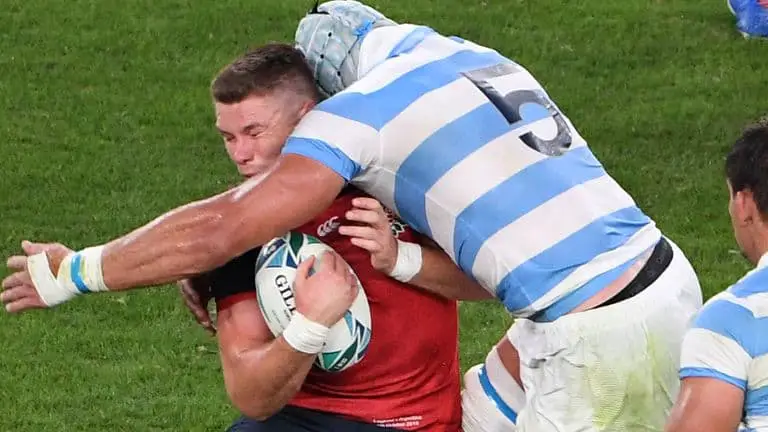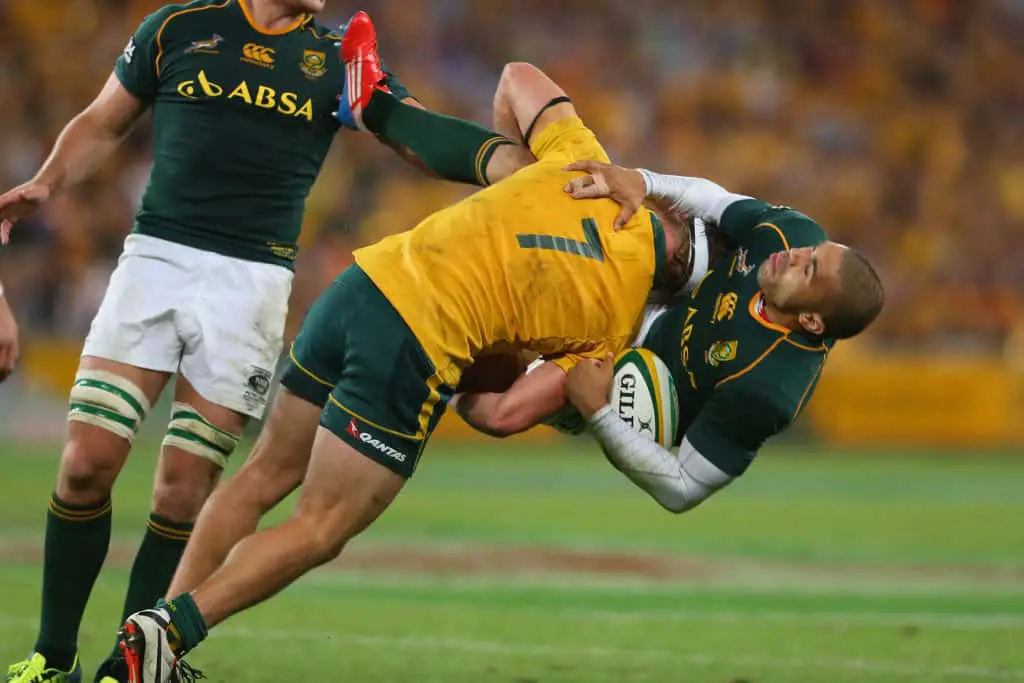
If you are sitting in the stands or watching rugby on TV you will have seen huge men running into each other at full speed, driving their shoulders into each other. Surely it must hurt being tackled so ferociously.
Do Rugby Tackles Hurt?
Most rugby tackles do not hurt, usually, the adrenaline masks any pain, and a player’s conditioning allows them to absorb the tackle unhurt. Certain tackles do hurt such as if a player is tackled unexpectedly or hit in a sensitive area such as ribs, knee, or head.
Rugby is a game that defies belief. How is it possible that players can sprint into each other and have high-impact collisions where both of them come crashing to the ground? Only for them to just pop back up and keep playing like nothing even happened.
A big reason rugby tackles don’t hurt is adrenaline and the intense focus of players. During a match players are fired up and ready to go to battle with their opposition. This causes a spike in adrenaline. When your adrenaline is shooting through the roof things that would typically hurt don’t even warrant a minor reaction from you.
This includes even high-impact collisions like rugby tackles. When a player is charging with the ball and adrenaline is pumping throughout their body they often won’t even feel the impact. The same goes for the tackler whose heart is pumping in anticipation of the contact.
Even if a rugby player does sustain an injury during a tackle they may not even realise for a long time after the incident when the adrenaline finally starts to wear off.
It isn’t just a rugby player’s adrenaline that allows them to endure tackles pain free it is also their intense focus. You know when you are so involved in what you are doing you completely tune out of the outside world you forget to drink or eat and block out all noise.
When rugby players are in the zone and so focused on competing and winning the match all of their brain power is focused on the task at hand. This level of focus is often enough for them not to feel the pain of rugby tackles.
Another reason rugby tackles don’t hurt is the player’s conditioning. The very first time you are tackled it is probably going to hurt a little. The 100th time a lot less and by the 1000th time, you won’t even bat an eye.
The body is an amazing machine and is able to adapt to the stress you place on it this includes enduring rugby tackles. Rugby players’ bodies are so used to being tackled that there is no longer a pain response.
It is the same with all sports. The first time you start lifting weights your body is going to be sore for days and days. After years of training even the most brutal workouts are not going to cause soreness like you first experienced.
Now while most rugby tackles do not hurt some do and can cause serious injuries. Rugby tackles often hurt when a player is blindsided and doesn’t see the tackle coming. In this situation the player doesn’t have time to brace for impact. Their body is relaxed which often leads to whiplash and can result in strains and tears.
Rugby tackles also hurt when players are hit in sensitive areas. It doesn’t matter how conditioned your body is if you get struck hard in the head or ribs you are going to feel it. Fortunately for rugby players tackles that make contact with the head are illegal and the perfect rib crushing tackle is not easy to pull off.
How Do You Tackle In Rugby Without Getting Hurt?
To tackle in rugby without getting hurt you need to lower your body height, drive off your back foot, step in close to your opposition, hit and drive with your shoulder, keep your head outside the body and maintain a strong flat back.

Tackling with correct technique will limit your chance of being injured. The first step to preventing injuries during contact is to maintain ideal body positioning throughout the tackle.
How to maintain ideal body positioning in rugby tackle:
Bend your legs – when tackling you need to get low to attack your opposition’s legs and lower rib cage, also during a tackle all your power comes from your legs so bend them and drive off the rugby turf with your back leg
Keep your back straight – a bent back not only limits the amount of power you can transfer to your opposition during the tackle but it also puts you at risk of injuring your back and neck, throughout the tackle maintain a strong flat back, bending your legs, looking slightly up and squeezing yours abs will help you keep a flat back
Core engaged – your core holds your body together to ensure your body is in a strong stable position, it needs to be working, to engage your core take a big breathe in and expand your diaphragm, as you are finishing the tackle you can exhale
Head up and outside your opposition’s body – you do not want your head in front of your opponent as this can lead to you being struck by your opponent’s knees or hip and you do not want you head inside as your opposition could fall on neck when you hit the rugby pitch
If you use correct technique when tackling and always ensure your body is in the ideal position throughout the contact phase your chance of getting hurt when tackling is low.
